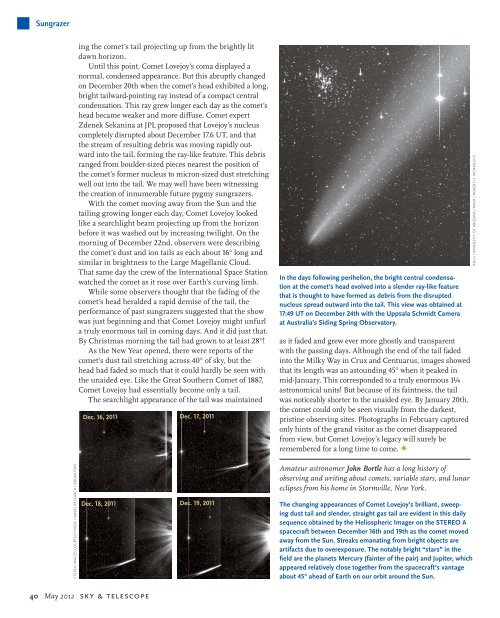Download this ebook as PDF - E-Book Library
Download this ebook as PDF - E-Book Library
Download this ebook as PDF - E-Book Library
You also want an ePaper? Increase the reach of your titles
YUMPU automatically turns print PDFs into web optimized ePapers that Google loves.
Sungrazer<br />
STEREO IMAGES COURTESY NASA / NAVAL RESEARCH LABORATORY<br />
ing the comet’s tail projecting up from the brightly lit<br />
dawn horizon.<br />
Until <strong>this</strong> point, Comet Lovejoy’s coma displayed a<br />
normal, condensed appearance. But <strong>this</strong> abruptly changed<br />
on December 20th when the comet’s head exhibited a long,<br />
bright tailward-pointing ray instead of a compact central<br />
condensation. This ray grew longer each day <strong>as</strong> the comet’s<br />
head became weaker and more diff use. Comet expert<br />
Zdenek Sekanina at JPL proposed that Lovejoy’s nucleus<br />
completely disrupted about December 17.6 UT, and that<br />
the stream of resulting debris w<strong>as</strong> moving rapidly outward<br />
into the tail, forming the ray-like feature. This debris<br />
ranged from boulder-sized pieces nearest the position of<br />
the comet’s former nucleus to micron-sized dust stretching<br />
well out into the tail. We may well have been witnessing<br />
the creation of innumerable future pygmy sungrazers.<br />
With the comet moving away from the Sun and the<br />
tailing growing longer each day, Comet Lovejoy looked<br />
like a searchlight beam projecting up from the horizon<br />
before it w<strong>as</strong> w<strong>as</strong>hed out by incre<strong>as</strong>ing twilight. On the<br />
morning of December 22nd, observers were describing<br />
the comet’s dust and ion tails <strong>as</strong> each about 16° long and<br />
similar in brightness to the Large Magellanic Cloud.<br />
That same day the crew of the International Space Station<br />
watched the comet <strong>as</strong> it rose over Earth’s curving limb.<br />
While some observers thought that the fading of the<br />
comet’s head heralded a rapid demise of the tail, the<br />
performance of p<strong>as</strong>t sungrazers suggested that the show<br />
w<strong>as</strong> just beginning and that Comet Lovejoy might unfurl<br />
a truly enormous tail in coming days. And it did just that.<br />
By Christm<strong>as</strong> morning the tail had grown to at le<strong>as</strong>t 28°!<br />
As the New Year opened, there were reports of the<br />
comet’s dust tail stretching across 40° of sky, but the<br />
head had faded so much that it could hardly be seen with<br />
the unaided eye. Like the Great Southern Comet of 1887,<br />
Comet Lovejoy had essentially become only a tail.<br />
The searchlight appearance of the tail w<strong>as</strong> maintained<br />
Dec. 16, 2011<br />
Dec. 18, 2011<br />
40 May 2012 sky & telescope<br />
Dec. 17, 2011<br />
Dec. 19, 2011<br />
In the days following perihelion, the bright central condensation<br />
at the comet’s head evolved into a slender ray-like feature<br />
that is thought to have formed <strong>as</strong> debris from the disrupted<br />
nucleus spread outward into the tail. This view w<strong>as</strong> obtained at<br />
17:49 UT on December 24th with the Uppsala Schmidt Camera<br />
at Australia’s Siding Spring Observatory.<br />
<strong>as</strong> it faded and grew ever more ghostly and transparent<br />
with the p<strong>as</strong>sing days. Although the end of the tail faded<br />
into the Milky Way in Crux and Centuarus, images showed<br />
that its length w<strong>as</strong> an <strong>as</strong>tounding 45° when it peaked in<br />
mid-January. This corresponded to a truly enormous 1¼<br />
<strong>as</strong>tronomical units! But because of its faintness, the tail<br />
w<strong>as</strong> noticeably shorter to the unaided eye. By January 20th,<br />
the comet could only be seen visually from the darkest,<br />
pristine observing sites. Photographs in February captured<br />
only hints of the grand visitor <strong>as</strong> the comet disappeared<br />
from view, but Comet Lovejoy’s legacy will surely be<br />
remembered for a long time to come. ✦<br />
Amateur <strong>as</strong>tronomer John Bortle h<strong>as</strong> a long history of<br />
observing and writing about comets, variable stars, and lunar<br />
eclipses from his home in Stormville, New York.<br />
The changing appearances of Comet Lovejoy’s brilliant, sweeping<br />
dust tail and slender, straight g<strong>as</strong> tail are evident in <strong>this</strong> daily<br />
sequence obtained by the Heliospheric Imager on the STEREO A<br />
spacecraft between December 16th and 19th <strong>as</strong> the comet moved<br />
away from the Sun. Streaks emanating from bright objects are<br />
artifacts due to overexposure. The notably bright “stars” in the<br />
fi eld are the planets Mercury (fainter of the pair) and Jupiter, which<br />
appeared relatively close together from the spacecraft’s vantage<br />
about 45° ahead of Earth on our orbit around the Sun.<br />
ANU / UNIVERSITY OF ARIZONA / NASA / ROBERT H. MCNAUGHT


